UMass Extension's Landscape Message is an educational newsletter intended to inform and guide Massachusetts Green Industry professionals in the management of our collective landscape. Detailed reports from scouts and Extension specialists on growing conditions, pest activity, and cultural practices for the management of woody ornamentals, trees, and turf are regular features. The following issue has been updated to provide timely management information and the latest regional news and environmental data.
Thanks for your continuing interest! To receive immediate notification when the next Landscape Message update is posted, be sure to join our e-mail list
To read individual sections of the message, click on the section headings below to expand the content:
Scouting Information by Region
Environmental Data
The following data was collected on or about April 19, 2023. Total accumulated growing degree days (GDD) represent the heating units above a 50ºF baseline temperature collected via regional NEWA stations (http://newa.cornell.edu) for the 2023 calendar year. This information is intended for use as a guide for monitoring the developmental stages of pests in your location and planning management strategies accordingly.
|
MA Region/Location |
GDD |
Soil Temp |
Precipitation |
Time/Date of Readings |
||
| (Gain since last report) |
2023 Total |
Sun |
Shade |
|||
| CAPE | 66 | 80 | 52 | 50 | 0.67 | 12:00 PM 4/19/2023 |
| SOUTHEAST | 72 | 91 | 58 | 51 | 0.05 | 3:00 PM 4/10/2023 |
| NORTH SHORE | 54 | 62 | 51 | 46 | 0.05 | 10:00 AM 4/19/2023 |
| EAST | 70 | 89 | 55 | 51 | 0.11 | 4:00 PM 4/19/2023 |
| METRO | 70 | 79 | 49 | 46 | 0.085 | 6:30 AM 4/19/2023 |
| CENTRAL | 84 | 91 | 49 | 48 | 0.11 | 7:00 AM 4/19/2023 |
| PIONEER VALLEY | 97 | 102 | 54 | 49 | 0.29 | 12:00 PM 4/19/2023 |
| BERKSHIRES | 88 | 93 | 50 | 47 | 0.44 | 9:00 AM 4/19/2023 |
Phenology
| Indicator Plants - Stages of Flowering (BEGIN, BEGIN/FULL, FULL, FULL/END, END) | ||||||||
|---|---|---|---|---|---|---|---|---|
| Cercis canadensis (redbud) | * | Begin | Full | Begin | Begin | begin | Full | Begin/Full |
| Amelanchier spp. (shadbush, serviceberry) | Begin | Full | Begin | Begin/Full | begin/full | begin/full | Full | Full |
| Pyrus calleryana (Callery pear) | Begin/Full | Full | Full | Full | Full | full | Full | Begin/Full |
| Magnolia soulangiana (saucer magnolia) | Full | Full | Full/End | Full | full | full | Full/End | Full |
| Prunus serrulata (Japanese flowering cherry) | ‘Kwanzan’* | * | Full | Full | full | full | * | Full |
| Rhododendron 'P. J. M.' | Full | Full | Full | Full | full | begin/full | Begin/Full | Begin |
| Rhododendron mucronulatum (Korean rhododendron) | * | * | * | Full | full | End | Full/end | * |
| Magnolia stellata (star magnolia) | Full/End | Full/end | Full | Full | full | full | Full | Full |
| Forsythia x intermedia (border Forsythia) | Full | Full | Full | Full | full | full | Full | Full |
| Pieris japonica (Japanese pieris) | End | Full | Full | Full | full/end | full | Full/End | Full |
| * = no activity to report/information not available | ||||||||
Regional Notes
Cape Cod Region (Barnstable)
General conditions: The average temperature from April 5 thru April 19 was 52˚F with a low of 30˚F on April 9 and a high of 84˚F on April 14. Sun, wind, low humidity, and above average temperatures through April 11th to the 15th created high-risk fire conditions and caused rapidly drying soils, especially worked or tilled soils. The above normal temperatures also resulted in rapid bud development of many species, which is concerning since the potential for freezing temperatures is still high. On April 16 just over half an inch of much-needed precipitation fell. Soil moisture is shallow.
Herbaceous plants seen in bloom include daffodil (Narcissus spp.), lenten rose (Helleborus spp.), hyacinth (Hyacinthus orientalis), grape hyacinth (Muscari armeniacum), lungwort (Pulmonaria officinalis) and barrenwort (Epimedium spp.).
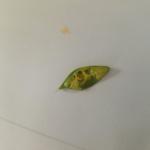
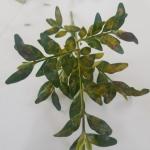 Pests/Problems: Few problems were observed in the landscape during the period. Winter injuries to broad and needle evergreens are still the most widespread problems observed. Forsythia bloom is limited on some plants as a result of winter injury. Low temperature injury to bigleaf hydrangea (H. macrophylla) is becoming more apparent as buds on woody stems continue to desiccate rather than develop. Winter moth caterpillars have begun to hatch and can be found feeding on buds of some rosaceae plants. Winter moth no longer requires management, with some exceptions including fruiting blueberry and apple. Boxwood leafminer damage was observed on boxwood: separating the upper and lower leaf surfaces of boxwood will reveal the orange larvae. Boxwood often display many injuries at this time of year including winter burn, leafminer damage and Volutella blight damage, which may look similar and often co-occur. Disease symptoms and signs observed during the period include black knot on Prunus and stem cankers on rose.
Pests/Problems: Few problems were observed in the landscape during the period. Winter injuries to broad and needle evergreens are still the most widespread problems observed. Forsythia bloom is limited on some plants as a result of winter injury. Low temperature injury to bigleaf hydrangea (H. macrophylla) is becoming more apparent as buds on woody stems continue to desiccate rather than develop. Winter moth caterpillars have begun to hatch and can be found feeding on buds of some rosaceae plants. Winter moth no longer requires management, with some exceptions including fruiting blueberry and apple. Boxwood leafminer damage was observed on boxwood: separating the upper and lower leaf surfaces of boxwood will reveal the orange larvae. Boxwood often display many injuries at this time of year including winter burn, leafminer damage and Volutella blight damage, which may look similar and often co-occur. Disease symptoms and signs observed during the period include black knot on Prunus and stem cankers on rose.

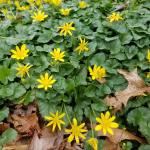 Weeds including bittercress (Cardamine hirsuta), mouse-ear cress (Arabidopsis thaliana) are in bloom and dispersing seed, chickweed (Stellaria media), fig buttercup (Ficaria verna), dandelion (Taraxacum officinale), corn speedwell (Veronica arvensis), deadnettle (Lamium purpureum), and common violet (Viola papilionacea) are all in bloom.
Weeds including bittercress (Cardamine hirsuta), mouse-ear cress (Arabidopsis thaliana) are in bloom and dispersing seed, chickweed (Stellaria media), fig buttercup (Ficaria verna), dandelion (Taraxacum officinale), corn speedwell (Veronica arvensis), deadnettle (Lamium purpureum), and common violet (Viola papilionacea) are all in bloom.
Rabbit damage has been observed on developing herbaceous plants.
Southeast Region (Dighton)
General Conditions: The last two weeks in April have been warm, dry, and breezy. We haven't had freezing temperatures since the morning of the fourth. Day temperatures were in the eighties on the fourteenth bringing a brief hint of summer. The caloric gain brought many plants into flower. Wind gusts were as high as twenty-one miles per hour on both the eleventh and the eighteenth. Precipitation has been alarmingly meager. Meteorologists are forecasting an El Niño year. Spring peepers can still be heard in the evening. Many young rabbit kits can be found in nests on lawns.
Plants in flower: Acer platanoides (Norway maple), A. saccharum (sugar maple), Amelanchier canadensis (shadblow), Aurinia saxatilis (Basket-of-Gold), Betula populifolia (gray birch), Cercis canadensis (redbud), Chaenomeles (flowering quince), Cornus florida (native flowering dogwood), Forsythia x intermedia (border forsythia), Hyacinthus orientalis (garden hyacinth), Leucojum aestivum (Loddon lily), Lindera benzoin (spicebush), Lunaria (honesty), Magnolia stellata (star magnolia), M.× soulangeana (saucer magnolia), Malus (apple), Muscari (grape hyacinth), Narcissus (daffodil), N. poeticus (poet's daffodil), Phlox stolonifera (creeping phlox), Pieris japonica (Japanese andrometer), Prunus (cherries), Pyrus (pears), Quercus (oak), Rhododendron 'PJM' (group), Spiraea, Tulipa (tulip), Viburnum carlesii (Korean spice viburnum), Vinca minor (myrtle)
Pests/Problems: European pine sawflies have hatched and are feeding on mugo pine. Dandelions are going to seed on lawns. Blackflies are biting aggressively near flowing water. The second instar of black-legged deer ticks, a significant percentage of which may be Lyme infected, are seeking new hosts. Male carpenter bees can be seen noisily squabbling over territories while they await the emergence of females. Annual bluegrass is flowering in lawns. Chickweed in lawns is senescent, yellowing, and going to seed. Despite the plentiful rain over Winter, we have not had any significant precipitation in the last two weeks. Dry patches can be seen in turf where the soil is thin. Those with allergies are complaining about pollen. Poison ivy has leafed out and can easily be identified by the small shiny red leaves on vines right now.
North Shore (Beverly)
General Conditions: Temperatures during this two week reporting period were very variable. During the first five days of this period temperatures were seasonable with average daily temperatures ranging from the mid 30s to mid 40s and maximum temperatures in the mid 40s to mid 50s. A change in the weather at the middle of the reporting period brought unseasonably warm temperatures for four days, with daily average temperatures ranging from low 60s to high 60s and maximum temperatures ranging from mid 70s to mid 80s. The last five days of the reporting period were seasonable with average daily temperatures ranging from mid 40s to low 50s and minimum temperatures in the low to mid 50s. The average daily temperature in the last two weeks was 51˚F with a minimum of 23˚F recorded on April 9, and a maximum of 84˚F recorded on April 14. We received minimal precipitation during this reporting period, with Long Hill receiving approximately 0.05 inches of rain. Woody plants seen in bloom include: Merrill magnolia (Magnolia x loebneri ‘Merrill’), Japanese pieris (Pieris japonica), star magnolia (Magnolia stellata), cylindrical magnolia (Magnolia cylindrica), Sargent cherry (Prunus sargentii), American filbert (Corylus americana), Winter hazel (Corylopsis winterthur), Callery Pear (Pyrus calleryana), and mountain pieris (Pieris floribunda). Spring flowering herbaceous plants in full bloom include: daffodils (Narcissus spp.), bloodroot (Sanguinaria canadensis), hellebores (Helleborus orientalis), and vinca (Vinca minor).
Pests/Problems: The spell of very cold weather in February seems to have affected the flower buds of some plants. The buds were developing well due unseasonably warm January but were killed by the extremely cold wind chill temperatures that occurred in February. Most Forsythia did not bloom as they should at this time of the year except those that were protected from the freezing cold wind. Weeping cherries and peaches have also not bloomed. Annual weed seeds continue to germinate. Norway maple (Acer platanoides) which is classified as an invasive plant is also in full bloom. No major pest activity was observed but ticks are active. It is important to protect yourself when working outdoors with a repellent such as DEET.
East Region (Boston)
General Conditions: Over the past two weeks daytime temperatures averaged 63˚F, with overnight temperatures averaging 43˚F, including three consecutive nights of 31˚F on the 8th, 9th and 10th. This also included a four day span of daytime temperatures averaging 81˚F from April 11-14 with a high of 89˚F on the 13th. We received measurable precipitation on only two of the past 14 days totaling 0.11 inches. Plants in bloom include: Forsythia x intermedia (border forsythia), Hyacinthus orientalis (garden hyacinth), Muscari spp. (grape hyacinth), Narcissus spp. (daffodil), Pieris japonica (Japanese andromeda), Pyrus calleryana (callery pear), Quercus spp. (oak) and Rhododendron 'PJM'.
Pests/Problems: Soils are extremely dry. Garlic mustard (Arrilaria petiolata) second year rosettes are flourishing. Japanese knotweed (Polygonum cuspidatum) red shoots have emerged from the soil. Dandelions (Taraxacum officinale) are in flower and distributing seed.
Metro West (Acton)
General Conditions: Happy Earth Week and early Earth Day! This year marks Earth Day’s 53rd anniversary. The landscape is filled with much activity and color, especially with the recent blast of hot weather followed by the rain over this past weekend. Lawns are greening up and growing; leaf and flower buds are expanding and opening; the smell of fresh mulch is in the air; and day length is increasing daily. As of Wednesday, April 19th, we are at 13 hours and 33 minutes with sunrise at 5:58 AM and sunset at 7:31 PM. A high temperature of 90° was recorded for the month on two days, the 13th and 14th.. A low temperature of 25° was recorded on the 9th. The average rainfall total for the month of April is 4.15”. I have recorded 0.42”, less than a half inch of rain in this area for this month so far. Twelve days remain in the month to record more precipitation and to close that gap!
Pests/Problems: Lack of any significant precipitation for the month is a concern. April showers are just not happening. During this two-week reporting period, there were six consecutive days without any amount of precipitation recorded and when there was precipitation to record, it was minimal at best. Acer platanoides (Norway Maple) is in full bloom. This invasive tree is hard to miss now that it is in bloom and its flowers are a bright yellowish-green and easily seen on trees found growing most everywhere. Also observed in the landscape is another problem plant seen flourishing most anywhere: the basal foliage of Alliaria petiolata (garlic mustard). Black flies are out.
Central Region (Boylston)
General Conditions: Weather this reporting period was quite variable, with low overnight temps in the 20’s to high daytime temps just over 90˚F. The intense hat at the end of last week spurred spring flowering and led to a slightly accelerated bloom time for tulips, magnolias, and some daffodils. The cooler temperatures during the second half of the reporting period has helped to slow their decline. Lots in bloom throughout the landscape, including Virginia bluebells (Mertensia virginica), bloodroot (Sanguinaria canadensis), and many, many bulbs!
Pests/Problems: The biggest problem is the lack of substantial rainfall. For the month of April, with a historical average of more than four inches of precipitation, we’ve recorded just over ½-inch. This repeats the same trend we saw last spring and is a concerning trend to watch over the coming weeks and months as we move into summer. Mosquitoes and ticks are quite active. Plenty of weeds are actively growing and flowering, including dandelion and henbit; second year garlic mustard (Alliaria petiolata) plants are growing quickly and getting ready to bolt.
Pioneer Valley (Amherst)
General Conditions: The spring season has rocketed forward in the Pioneer Valley since our last report. A five-day span of bright sun and progressively warming temperatures saw us climb from 69°F (4/10) to a staggering 93°F (4/14). Both 4/13 and 4/14 were unbearably hot for mid-April, especially with the lack of shade from deciduous trees, and new record high daily temperatures were established in Springfield. Red flag warnings, indicating ideal conditions for wildfire development, were hoisted several times due to low humidity and strong winds. An air quality alert was also enacted on 4/14 as ozone reached levels that could affect sensitive groups. Nighttime low temperatures in the 50s during this unseasonably warm span liberated plants from the cold that often constrains growth this time of year. As a result, a wide array of trees and shrubs are now leafing out, including witch hazel, Japanese maple, redbud, crabapple, viburnum, stewartia, katsura, serviceberry and privet. Mid-April is a tenuous time for leaf out and low temperatures dipping close to freezing on 4/19 and 4/20 were concerning. A report from the UMass Cold Spring Orchard predicts apple and pear blooming will begin around 4/22, after the latest round of warm weather. On the coniferous side, arborvitae, false-cypress, juniper and ginkgo are putting on new growth. Pine candles are elongating and hemlock and yew buds are swelling. The first half of April was also quite dry, with no measurable precipitation from 4/2 to 4/15. Highly scattered showers from 4/15 through 4/18 produced only minimal accumulations (<0.5”), but cooler temperatures and the light drizzle provided some relief and stimulated more flowering. In some locations, the uppermost soil horizon is drying out but there is still plentiful soil moisture in deeper horizons. Sugar maple, Norway maple and various birch species have been in full flower, producing a significant percentage of pollen in the air. Turfgrasses have quickly transformed from dormant brown to a lush, vibrant green. The soundscape is increasingly active with the mating calls of peepers and tree frogs along with a variety of migratory birds. A variety of bees, fireflies, lady beetles, hover flies and other beneficial or benign insects are also abundant now in the landscape.
Pests/Problems: As we continue to assess winter injury on trees and shrubs, Weeping Higan cherry (Prunus x subhirtella 'Pendula') are not flowering and this is very troubling. A large and old specimen with a broad canopy on the UMass campus should be in peak bloom right now but has no flowers. Additional specimens around Hampshire County also show no activity. The early February arctic freeze is the most likely culprit for the injury. The ubiquitous Snow Fountain cherry (Prunus 'Snofozam') has flowered normally throughout the area. Some trees appeared thin but they can be so badly pruned it’s hard to assess health in some cases. It also appears some Forsythia were injured by the freeze as well. Weak flowering has been observed on various plants and drought may have also been a factor. Aside from certain flowering cherries and scattered forsythias, it appears many plants are largely unscathed after the winter season. Exceptions exist, of course, with some plants (e.g. American holly, rhododendron and redbud) exhibiting symptoms of desiccation and freeze injury. It’s still too early to determine how rhododendron and azalea flowering was affected by the cold. PJM rhododendrons are flowering normally, but these cultivars are extremely cold hardy. Snowball aphid activity on viburnum will be evident soon as new growth develops. Damage is usually minor and plants grow out of the injury. Viburnums may also have blighted shoot tips with peeling bark, often the result of winter injury. This is common for these plants and they should be pruned out as soon as possible. There are a variety of small green caterpillars that chew and roll leaves early in the season. Bruce spanworm (Operophtera bruceata), a native pest of forest and landscape trees, and the redbanded leafroller (Argyrotaenia velutinana) are examples. Close examination of developing leaves on younger and accessible trees is necessary to observe feeding injury. Hand picking/crushing is sufficient on smaller trees. Orange spore masses produced by rust pathogens (Gymnosporangium spp.) will soon be developing on Juniperus. When especially numerous, they can be pruned out and discarded. Several azaleas and rhododendrons with suspected iron deficiency were observed. Symptoms include interveinal chlorosis on the foliage (particularly the newest foliage), stunted growth and canopy dieback. Reducing soil pH, with sulfur for example, can help to correct the issue. Continue to prune out dead twigs and branches while they are most visible. Mosquitoes, black flies and paper wasps have emerged. Garden weeds are quickly developing along with invasive plants like honeysuckle and Oriental bittersweet.
Berkshire Region (West Stockbridge)
General Conditions: Again, weather conditions this spring have alternated between rather cold to unusually warm with some record setting high temperatures. Lows at the three National Weather Service sites in Berkshire County were: 24°F on April 9 in North Adams, 26°F on April 8 & 9 at the Pittsfield Airport, and 23°F on April 8 in Richmond. In contrast, there were record highs on April 14 with 88°F in North Adams, and 86°F in both Pittsfield and Richmond. The 80+ degree temperatures persisted for three days. The thermometer has once again flipped with temperatures dropping to freezing or just below freezing on the morning of April 19. Very brief snow flurries were experienced in a few locations. Precipitation has been scant. Soil moisture levels are low. Even after a rainfall of 0.2 inches on April 17th, dry soil could be seen by simply scratching the upper 1 ½ inches of soil. The unseasonably warm conditions from the 10th through the 16th spurred extensive blooming of spring blooming trees and shrubs as well as the emergence and bloom of spring bulbs. Suddenly, the landscape has gone from gray/brown to light green as leaves of deciduous trees have begun to develop. There is also a surge in growth of turfgrass and mowing season is underway.
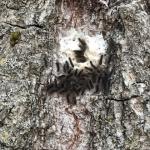 Pests/Problems: The frequency of tick bites among landscape/garden workers has increased considerably. It is essential that workers take precautions to protect themselves from tick bites. Deer browsing continues to be an issue, especially on favored bulbs such as tulips that are now fully developed. Lily leaf beetle adults are actively feeding on emerging lily foliage. The larvae of boxwood leafminer can be seen by slicing open the blister-like swellings on boxwood foliage. Most interesting is the very early emergence of the tiny caterpillars of the spongy moth (Lymantria dispar) from the egg patches on the trunks and stems of trees. After two years of heavy infestation and widespread defoliation of susceptible tree species in southwestern Berkshire County, it was thought that the population may be in decline but that may not be the case. Time will tell.
Pests/Problems: The frequency of tick bites among landscape/garden workers has increased considerably. It is essential that workers take precautions to protect themselves from tick bites. Deer browsing continues to be an issue, especially on favored bulbs such as tulips that are now fully developed. Lily leaf beetle adults are actively feeding on emerging lily foliage. The larvae of boxwood leafminer can be seen by slicing open the blister-like swellings on boxwood foliage. Most interesting is the very early emergence of the tiny caterpillars of the spongy moth (Lymantria dispar) from the egg patches on the trunks and stems of trees. After two years of heavy infestation and widespread defoliation of susceptible tree species in southwestern Berkshire County, it was thought that the population may be in decline but that may not be the case. Time will tell.
Regional Scouting Credits
- CAPE COD REGION - Russell Norton, Horticulture and Agriculture Educator with Cape Cod Cooperative Extension, reporting from Barnstable.
- SOUTHEAST REGION - Brian McMahon, Arborist, reporting from the Dighton area.
- NORTH SHORE REGION - Geoffrey Njue, Green Industry Specialist, UMass Extension, reporting from the Long Hill Reservation, Beverly.
- EAST REGION - Kit Ganshaw & Sue Pfeiffer, Horticulturists reporting from the Boston area.
- METRO WEST REGION – Julie Coop, Forester, Massachusetts Department of Conservation & Recreation, reporting from Acton.
- CENTRAL REGION - Mark Richardson, Director of Horticulture reporting from New England Botanic Garden at Tower Hill, Boylston.
- PIONEER VALLEY REGION - Nick Brazee, Plant Pathologist, UMass Extension Plant Diagnostic Lab, reporting from Amherst.
- BERKSHIRE REGION - Ron Kujawski, Horticultural Consultant, reporting from Great Barrington.
Woody Ornamentals
Diseases
Recent pests and pathogens of interest seen in the UMass Extension Plant Diagnostic Lab, a select few:
- Spider mite infestation (Oligonychus ununguis), needle blight (Phyllosticta and Pestalotiopsis) and suspected winter injury on Green Giant arborvitae (Thuja plicata × standishii). Green Giants are extremely popular right now, in part because of their rapid growth rates. Several trees, approximately eight-years-old, were transplanted in late 2021. They were established as a hedgerow along a 4’ fence with a mixture of sun and shade in well-drained, loam-based soils. Ten trees died last year and were replaced, but now several more trees are declining (off color to brown foliage). Spider mite injury was abundant on the submitted sample along with symptoms of arborvitae needle blight. A short incubation produced Phyllosticta and Pestalotiopsis, both common pathogens of weakened and stressed arborvitae in the region. Symptoms of winter injury were also present and transplant shock can make trees more susceptible to this type of injury.
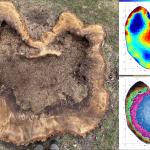 Root and butt rot of northern red oak (Quercus rubra). Large and mature tree (49” dbh) on the UMass campus in a tree belt that experiences little foot traffic. The tree exhibited excessive basal tapering (also known as basal swelling or “bottle butt”) that can indicate internal decay is present. To illustrate how significantly tapered the base of the tree was, at a height of 15” from the soil, the diameter of the trunk was a staggering 76”. Sonic and electrical resistance tomography indicated a large area of decay with a cavity forming. Subsequent resistance drilling around the base also indicated decay was present. The tree was struck by lightning in recent years, creating a long vertical wound on the trunk, but remained in respectable health. However, it was decided to remove the tree late last month, allowing for confirmation of the decay area. The sonic tomogram appears to have slightly overestimated the area of decay, which can occur on large diameter, irregularly-shaped cross sections.
Root and butt rot of northern red oak (Quercus rubra). Large and mature tree (49” dbh) on the UMass campus in a tree belt that experiences little foot traffic. The tree exhibited excessive basal tapering (also known as basal swelling or “bottle butt”) that can indicate internal decay is present. To illustrate how significantly tapered the base of the tree was, at a height of 15” from the soil, the diameter of the trunk was a staggering 76”. Sonic and electrical resistance tomography indicated a large area of decay with a cavity forming. Subsequent resistance drilling around the base also indicated decay was present. The tree was struck by lightning in recent years, creating a long vertical wound on the trunk, but remained in respectable health. However, it was decided to remove the tree late last month, allowing for confirmation of the decay area. The sonic tomogram appears to have slightly overestimated the area of decay, which can occur on large diameter, irregularly-shaped cross sections.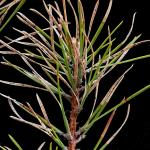 Lophodermium needlecast of pitch pine (Pinus rigida). The sample originated from a cohort of young pitch pine growing in full sun. The trees are experiencing dieback and the symptoms have quickly progressed. Pitch pine can be susceptible to several needlecast diseases, and Lophodermium is often considered one of the less important on this host. However, in 2021 there was a large outbreak of Lophodermium needlecast on pitch pine in Massachusetts across forests and managed landscapes. Drought stress is likely contributing to the disease, despite the tree’s ability to withstand difficult growing conditions. Lophodermium produces black, football-shaped fruiting bodies on the needle surface that are readily viewed with a hand lens.
Lophodermium needlecast of pitch pine (Pinus rigida). The sample originated from a cohort of young pitch pine growing in full sun. The trees are experiencing dieback and the symptoms have quickly progressed. Pitch pine can be susceptible to several needlecast diseases, and Lophodermium is often considered one of the less important on this host. However, in 2021 there was a large outbreak of Lophodermium needlecast on pitch pine in Massachusetts across forests and managed landscapes. Drought stress is likely contributing to the disease, despite the tree’s ability to withstand difficult growing conditions. Lophodermium produces black, football-shaped fruiting bodies on the needle surface that are readily viewed with a hand lens.
Report by Nick Brazee, Plant Pathologist, UMass Extension Plant Diagnostic Lab, UMass Amherst.
Insects and Other Arthropods
Woody ornamental insect and non-insect arthropod pests to consider, a selected few:
Deer Tick/Blacklegged Tick: Ixodes scapularis adults are active all winter, as they typically are from October through May, and “quest” or search for hosts at any point when daytime temperatures are above freezing. Engorged females survive the winter and will lay 1,500+ eggs in the forest leaf litter beginning around Memorial Day (late May). For images of all deer tick life stages, along with an outline of the diseases they carry, visit: https://web.uri.edu/tickencounter/species/blacklegged-tick/ .
Anyone working in the yard and garden should be aware that there is the potential to encounter deer ticks. The deer tick or blacklegged tick can transmit Lyme disease, human babesiosis, human anaplasmosis, and other diseases. Preventative activities, such as daily tick checks, wearing appropriate clothing, and permethrin treatments for clothing (according to label instructions) can aid in reducing the risk that a tick will become attached to your body. If a tick cannot attach and feed, it will not transmit disease. For more information about personal protective measures, visit: https://web.uri.edu/tickencounter/prevention/protect-yourself/ .
The Center for Agriculture, Food, and the Environment provides a list of potential tick identification and testing resources here: https://ag.umass.edu/resources/tick-testing-resources .
*In the news: UMass Amherst has now been designated as the location for the New England Center of Excellence in Vector-Borne Diseases (NEWVEC). This CDC (Centers for Disease Control and Prevention) funded center will work to reduce the risk of vector-borne diseases spread by ticks, mosquitoes, and other blood-sucking insects or insect relatives in New England: https://www.umass.edu/news/article/cdc-designates-new-england-center-exc.... For more information and to contact NEWVEC, visit: https://www.newvec.org/ . To contact the center for more information about their Spring 2023 Project ITCH (“Is Tick Control Helping”), visit: https://www.newvec.org/itch .
Highlighted Invasive Insects & Other Organisms Update:
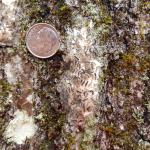 Spongy Moth: Lymantria dispar egg masses will be seen overwintering on just about any flat surface, including host plants such as oak, but also fencing, buildings, steps, outdoor furniture, and more. The end of winter and start of spring is a good time to scout properties, particularly in areas of Berkshire County, MA and abutting locations in CT and NY that experienced elevated L. dispar populations in 2022. If large numbers of egg masses are seen, plan to monitor them between 90-100 growing degree days (roughly the first week in May, but this varies) to better time egg hatch and caterpillar emergence. The MA Department of Conservation and Recreation, Forest Health Program reports that winter counts of spongy moth egg masses are higher than hoped for in parts of Berkshire County coming into the spring of 2023. This may mean that spongy moth caterpillars will again be noticeable in these areas this year, despite seeing caterpillar die-off from the spongy moth killing fungus Entomophaga maimaiga last season. For more information from the Forest Health Program, visit: https://storymaps.arcgis.com/stories/b60f63199fa14805a8b9f7c82447a25b and look under the spongy moth navigation tab.
Spongy Moth: Lymantria dispar egg masses will be seen overwintering on just about any flat surface, including host plants such as oak, but also fencing, buildings, steps, outdoor furniture, and more. The end of winter and start of spring is a good time to scout properties, particularly in areas of Berkshire County, MA and abutting locations in CT and NY that experienced elevated L. dispar populations in 2022. If large numbers of egg masses are seen, plan to monitor them between 90-100 growing degree days (roughly the first week in May, but this varies) to better time egg hatch and caterpillar emergence. The MA Department of Conservation and Recreation, Forest Health Program reports that winter counts of spongy moth egg masses are higher than hoped for in parts of Berkshire County coming into the spring of 2023. This may mean that spongy moth caterpillars will again be noticeable in these areas this year, despite seeing caterpillar die-off from the spongy moth killing fungus Entomophaga maimaiga last season. For more information from the Forest Health Program, visit: https://storymaps.arcgis.com/stories/b60f63199fa14805a8b9f7c82447a25b and look under the spongy moth navigation tab.
If egg masses are plentiful near high-value specimen trees in Berkshire County in 2023, consider applying the reduced risk insecticide Bacillus thuringiensis Kurstaki (Btk) to host plant leaves before caterpillars are over ¾ inch in length. Work with a licensed pesticide applicator and arborist to plan these applications, if necessary, especially if a high-value host plant was defoliated by this insect in 2021 or 2022.
Additionally, we’ve been asked about wrapping trees to prevent spongy moth caterpillars from accessing the canopy to feed. Here is some information. If you are interested in wrapping trees or shrubs with a sticky barrier to capture older, crawling spongy moth caterpillars, there are a few things to consider. 1) This will not prevent all caterpillars from accessing the tree to feed, nor is it a guarantee that no foliage will be eaten by them on the plant to which it has been applied. 2) This will not prevent the tiniest of caterpillars (newly hatched) from ballooning on the wind into tall trees and settling to feed. For example, this could mean that caterpillars will still have some access to the leaves following their dispersal in the spring. 3) Do not apply any sticky substances directly to the tree or shrub bark to avoid risk of injury to the plant. 4) Sticky bands will need to be monitored frequently throughout the growing season, particularly in mid-to-late May and especially June, to clean and replace them. If the bands become covered in dead caterpillars, living ones can crawl over the dead and still access the leaves of the tree. You do not have to hang the bands up now, but now is a good time to purchase necessary materials if you are interested in doing this on a few trees or shrubs in your yard. It is recommended that bands be placed on trees (and sticky material on the bands) once the caterpillars are approximately an inch in length. This may be approximately in early or mid-June. Bands should then be left up and changed frequently through July, until the caterpillars have pupated. This technique may work best with an engaged property owner that is willing and able to frequently check and help change the bands. For more information, visit: https://www.canr.msu.edu/resources/using-bands-to-protect-shade-trees-from-spongy-moth
The good news – homeowners in central and eastern Massachusetts will hopefully not have to worry too much about spongy moth this year. It may be undetectable in many central and eastern MA locations. MA DCR reports not seeing significant overwintering spongy moth egg masses in those locations. The primary area of concern includes parts of southwestern Berkshire County.
For more information about spongy moth, view the first episode of InsectXaminer, here: https://ag.umass.edu/landscape/education-events/insectxaminer .
Why did the common name for Lymantria dispar change recently? More information is available here: https://entsoc.org/news/press-releases/spongy-moth-approved-new-common-name-lymantria-dispar .
 Hemlock Woolly Adelgid: Adelges tsugae is present on eastern and Carolina hemlock. The overwintering hemlock woolly adelgid generation (sistens) is present through mid-spring and produces the spring generation (progrediens) which will be present from early spring through mid-summer. HWA, unlike many other insects, does most of its feeding over the winter. Hemlock woolly adelgid winter mortality (due to two significant regional cold snap events) is expected to be high for 2023. HWA that were most likely to survive these extreme cold events are those on lower host tree branches, if they were insulated by snow pack at the time. Determine if HWA are alive or dead on host plants before making chemical management decisions. This can be done quickly in the field by squishing overwintered HWA in their ovisacs between your thumb and forefinger and looking for a dark brown/blackish stain (from the hemolymph, or insect blood). If staining does not occur, the insect may have died and dried up. Test at least a few insects on at least a few branches to determine if any are alive. (Much more extensive examination may involve viewing at least 200 adelgids per site/location to calculate percent winter mortality.)
Hemlock Woolly Adelgid: Adelges tsugae is present on eastern and Carolina hemlock. The overwintering hemlock woolly adelgid generation (sistens) is present through mid-spring and produces the spring generation (progrediens) which will be present from early spring through mid-summer. HWA, unlike many other insects, does most of its feeding over the winter. Hemlock woolly adelgid winter mortality (due to two significant regional cold snap events) is expected to be high for 2023. HWA that were most likely to survive these extreme cold events are those on lower host tree branches, if they were insulated by snow pack at the time. Determine if HWA are alive or dead on host plants before making chemical management decisions. This can be done quickly in the field by squishing overwintered HWA in their ovisacs between your thumb and forefinger and looking for a dark brown/blackish stain (from the hemolymph, or insect blood). If staining does not occur, the insect may have died and dried up. Test at least a few insects on at least a few branches to determine if any are alive. (Much more extensive examination may involve viewing at least 200 adelgids per site/location to calculate percent winter mortality.)
Eggs may be found in woolly masses at the base of hemlock needles beginning in mid-March. Each woolly mass is created by a female who may then lay 50-300 eggs. Eggs hatch and crawlers may be found from mid-March through mid-July. Infested trees may be treated with foliar sprays in late April to early May, using Japanese quince as a phenological indicator. Systemic* applications may be made in the spring and fall, or when soil conditions are favorable for translocation to foliage. Nitrogen fertilizer applications may make hemlock woolly adelgid infestations worse.
For more information, visit: https://ag.umass.edu/landscape/fact-sheets/hemlock-woolly-adelgid .
*Note: beginning July 1, 2022 systemic insecticides known as neonicotinoids (including imidacloprid) have become state restricted use for tree and shrub uses in Massachusetts. More information is available, here:https://www.mass.gov/service-details/pesticide-newsupdates
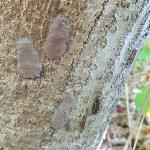 Spotted Lanternfly: (Lycorma delicatula, SLF) is a non-native, invasive insect that feeds on over 103 species of plants, including many trees and shrubs that are important in our landscapes. It overwinters as an egg mass, which the adult female insect lays on just about any flat surface. Pictures of egg masses can be seen here:https://massnrc.org/pests/linkeddocuments/SLFChecklistForResidents.pdf
Spotted Lanternfly: (Lycorma delicatula, SLF) is a non-native, invasive insect that feeds on over 103 species of plants, including many trees and shrubs that are important in our landscapes. It overwinters as an egg mass, which the adult female insect lays on just about any flat surface. Pictures of egg masses can be seen here:https://massnrc.org/pests/linkeddocuments/SLFChecklistForResidents.pdf
Currently, the only established populations of spotted lanternfly in Massachusetts are in Fitchburg, Shrewsbury, Worcester, and Springfield MA. Therefore, there is no reason to be preemptively treating for this insect in other areas of Massachusetts. If you suspect you have found spotted lanternfly in additional locations, please report it immediately to MDAR here: https://massnrc.org/pests/slfreport.aspx . If you are living and working in the Fitchburg, Shrewsbury, Worcester, and Springfield, MA areas, please be vigilant and continue to report anything suspicious.
For More Information:
From UMass Extension:
*New*: Spotted Lanternfly Management Guide for Professionals:https://ag.umass.edu/landscape/fact-sheets/spotted-lanternfly-management
*Note that management may only be necessary in areas where this insect has become established in Massachusetts, and if high value host plants are at risk. Preemptive management of the spotted lanternfly is not recommended.
Fact Sheet:https://ag.umass.edu/landscape/fact-sheets/spotted-lanternfly
Check out the InsectXaminer Episode about spotted lanternfly adults and egg masses! Available here:https://ag.umass.edu/landscape/education-events/insectxaminer
From the MA Department of Agricultural Resources:
Fact Sheet and Map of Locations in MA:https://massnrc.org/pests/pestFAQsheets/spottedlanternfly.html
Spotted Lanternfly Management Guide for Homeowners in Infested Areas:https://massnrc.org/pests/linkeddocuments/SLFHomeownerMgmtGuide.pdf
- Asian Longhorned Beetle: (Anoplophora glabripennis, ALB) Look for signs of an ALB infestation which include perfectly round exit holes (about the size of a dime), shallow oval or round scars in the bark where a female has chewed an egg site, or sawdust-like frass (excrement) on the ground nearby host trees or caught in between branches. Be advised that other, native insects may create perfectly round exit holes or sawdust-like frass, which can be confused with signs of ALB activity.
The regulated area for Asian longhorned beetle is 110 square miles encompassing Worcester, Shrewsbury, Boylston, West Boylston, and parts of Holden and Auburn. If you believe you have seen damage caused by this insect, such as exit holes or egg sites, on susceptible host trees like maple, please call the Asian Longhorned Beetle Eradication Program office in Worcester, MA at 508-852-8090 or toll free at 1-866-702-9938.
To report an Asian longhorned beetle find online or compare it to common insect look-alikes, visit: http://massnrc.org/pests/albreport.aspx orhttps://www.aphis.usda.gov/pests-diseases/alb/report .
 Emerald Ash Borer: (Agrilus planipennis, EAB) has been detected in at least 11 out of the 14 counties in Massachusetts.A map of these locations across the state may be found here:https://ag.umass.edu/fact-sheets/emerald-ash-borer . Additional information about this insect is provided by the MA Department of Conservation and Recreation, here:https://storymaps.arcgis.com/stories/b60f63199fa14805a8b9f7c82447a25b .
Emerald Ash Borer: (Agrilus planipennis, EAB) has been detected in at least 11 out of the 14 counties in Massachusetts.A map of these locations across the state may be found here:https://ag.umass.edu/fact-sheets/emerald-ash-borer . Additional information about this insect is provided by the MA Department of Conservation and Recreation, here:https://storymaps.arcgis.com/stories/b60f63199fa14805a8b9f7c82447a25b .
This wood-boring beetle readily attacks ash (Fraxinus spp.) including white, green, and black ash and has also been found developing in white fringe tree (Chionanthus virginicus) and has been reported in cultivated olive (Olea europaea). Signs of an EAB infested tree may include D-shaped exit holes in the bark (from adult emergence), “blonding” or lighter coloration of the ash bark from woodpecker feeding (chipping away of the bark as they search for larvae beneath), and serpentine galleries visible through splits in the bark, from larval feeding beneath. It is interesting to note that woodpeckers are capable of eating 30-95% of the emerald ash borer larvae found in a single tree (Murphy et al. 2018). Unfortunately, despite high predation rates, EAB populations continue to grow. However, there is hope that biological control efforts will eventually catch up with the emerald ash borer population and preserve some of our native ash tree species for the future.
- Winter Moth: (Operophtera brumata) data since 2017 has indicated that the winter moth population in eastern Massachusetts has been on the decline while the percent of winter moth pupae parasitized by Cyzenis albicans has increased! Dr. Joseph Elkinton’s laboratory at UMass Amherst has released this biological control agent of winter moth since 2005 and conducted the rigorous sampling required to determine where the insect has established and what its impact on the winter moth population has been at multiple sites in eastern MA.
The take-home point? Do not worry about winter moth this spring! In fact, management of this insect in landscaped settings will likely not be necessary in most locations. Blueberry growers may still, on the other hand, be interested in scouting and continuing to monitor for this insect, as only very low numbers of winter moth caterpillars might be tolerated in that system. In recent years, it is worth-while to note that some areas on the Cape and other locations in eastern MA have reported noticeable native cankerworm populations in the spring, which are often confused for winter moth. Read more about cankerworms in the spring scouting list below.
- Jumping Worms: Amynthas spp. earthworms, collectively referred to as “jumping or crazy or snake” worms, overwinter as eggs in tiny, mustard-seed sized cocoons found in the soil or other substrate (ex. compost). The tiny, impossible to remove cocoons have overwintered and may provide a population of these earthworms in the 2023 season.
For More Information:
UMass Extension Fact Sheets:
- Earthworms in Massachusetts – History, Concerns, and Benefits: https://ag.umass.edu/landscape/fact-sheets/earthworms-in-massachusetts-history-concerns-benefits
- Jumping/Crazy/Snake Worms – Amynthas spp.: https://ag.umass.edu/landscape/fact-sheets/jumpingcrazysnake-worms-amynthas-spp
- A Summary of the Information Shared at UMass Extension’s Jumping Worm Conference in January 2022: https://ag.umass.edu/news-events/highlights/jumping-worms-conference
- Invasive Jumping Worm Frequently Asked Questions (Over 70 Questions and their Answers): https://ag.umass.edu/landscape/fact-sheets/invasive-jumping-worm-frequently-asked-questions
Spring Scouting Suggestions & Preparation for Upcoming Tree & Shrub Insects (Native and Invasive):
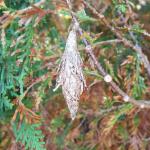 Bagworm:Thyridopteryx ephemeraeformis is a native species of moth whose larvae construct bag-like coverings over themselves with host plant leaves and twigs. This insect overwinters in the egg stage, within the bags of deceased females from last season. Eggs may hatch and young larvae are observed feeding around mid-June, or roughly between 600-900 GDD’s. Now is the time to scout for and remove and destroy overwintering bags. More information can be found here:https://ag.umass.edu/landscape/fact-sheets/bagworm
Bagworm:Thyridopteryx ephemeraeformis is a native species of moth whose larvae construct bag-like coverings over themselves with host plant leaves and twigs. This insect overwinters in the egg stage, within the bags of deceased females from last season. Eggs may hatch and young larvae are observed feeding around mid-June, or roughly between 600-900 GDD’s. Now is the time to scout for and remove and destroy overwintering bags. More information can be found here:https://ag.umass.edu/landscape/fact-sheets/bagworm- Balsam Twig Aphid: Mindarus abietinus overwinters as a silvery colored egg on host plant twigs. Eggs hatch just prior to budbreak and nymphs feed for a period of time on the undersides of last season’s needles before molting into a wingless stem mother. Stem mothers move to buds just as they open and give “live birth” to second generation nymphs. These second generation nymphs are the most damaging, feeding on new needles as they elongate, causing distortion and stunting. Excessive amounts of honeydew may be produced and cause needles to stick together. Foliar applications, if needed, may be made between 30-100 GDD’s, base 50°F on warm days before budcaps loosen. Inspect the twigs, near the base of needles of Balsam fir, Fraser fir, and other true firs for overwintering eggs and eventually the needles for feeding nymphs. This insect may be most problematic in Christmas tree production. In landscapes, many natural enemies can provide adequate management of this insect.
-
Black Turpentine Beetle: Dendroctonus terebrans adults may begin to be active between mid-April to mid-May. Host plants include: black pine (Pinus thunbergiana), eastern white pine (Pinus strobus), Japanese black pine (Pinus thunbergii), loblolly pine (Pinus taeda), pitch pine (Pinus rigida), red spruce (Picea rubens), Scots pine (Pinus sylvestris), and slash pine (Pinus elliottii).
This is one of the largest native North American bark beetles. In the northern parts of its extensive range, the black turpentine beetle overwinters as an adult in the bark of its hosts. In the southern portions of its range, all life stages may be present throughout the year. Egg laying and feeding is usually kept to the basal 6 feet of the host plant. Mated pairs of adult beetles work to excavate galleries that may be 9.8 inches wide and 11.8 inches long. 100-200 eggs may be laid on one side of the gallery. Once hatched, larvae feed in groups on the inner bark. Fully grown larvae are legless, white, and almost 1/2 inch in length. Pupation occurs and adults eventually emerge from the bark to re-infest the same tree, or disperse to another susceptible host.
Stumps and buttress roots of freshly cut trees are favored by this insect. Attacked trees may exhibit browning of needles and oozing of large masses of pitch. Masses of pitch (pitch tubes) may cover holes in the trunk and may be considerably larger than those of southern pine beetle. Pitch hardens and is first white but may turn red as it ages. Pitch is irregular in shape and up to 1.6 inches in diameter. Pitch tubes not visible when the area below soil line is attacked. Healthy trees are usually not attacked, however it has been reported on occasion.
Check drought-stressed or otherwise stressed trees for needles turning light green to rust color. Check the lower 6 feet, particularly the lower 18 inches of the trunk for 1.6 inch in diameter pitch tubes or small entrance holes from the adults. Reddish-brown boring dust may be found near the base of the tree as well.
- Boxwood Leafminer: Monarthropalpus flavus partly grown fly larvae overwinter in the leaves of susceptible boxwood. Yellowish mines may be noticeable on the undersides of leaves. This insect grows rapidly in the spring, transforming into an orange-colored pupa. After pupation, adults will emerge and white colored pupal cases may hang down from the underside of leaves where adults have emerged. Adults may be observed swarming hosts between 300-650 GDD’s, or roughly the end of May through June. Most cultivars of Buxus sempervirens and B. microphylla are thought to be susceptible. If installing new boxwoods this spring, resistant cultivars such as ‘Vardar Valley’ and ‘Handsworthiensis’ are good choices at sites where this insect has been a problem. For more information, visit: https://ag.umass.edu/landscape/fact-sheets/boxwood-leafminer
- Boxwood Mite: Eurytetranychus buxi overwinter as tiny eggs on boxwood leaves and hatch mid-spring. These mites are tiny (about the size of a period) and difficult to detect. Feeding may cause plants to appear off-color. If management is deemed necessary, the timing for treatment may be between 245-600 GDD’s or roughly the beginning of May.
- Boxwood Psyllid: Psylla buxi feeding can cause cupping of susceptible boxwood leaves. Leaf symptoms/damage may remain on plants for up to two years. English boxwood may be less severely impacted by this pest. Eggs overwinter, buried in budscales, and hatch around budbreak of boxwood. Eggs may hatch around 80 GDD’s. While foliar applications may be made between 290-440 GDD’s, the damage caused by this insect is mostly aesthetic. Therefore, typically, management is not necessary. For more information, visit: https://ag.umass.edu/landscape/fact-sheets/boxwood-psyllid .
- Cankerworms: Alsophila pometaria (fall cankerworm) and Paleacrita vernata (spring cankerworm) are often confused for winter moth (Operophtera brumata). Cankerworm populations in eastern MA, particularly on areas of Cape Cod, were confused for winter moth in 2019. Spring cankerworm adults are active in February and March, and fall cankerworm adults are active in late November into early December. During these times, both species lay eggs. These native insects most commonly utilize elm, apple, oak, linden, and beech. Eggs of both species hatch as soon as buds begin to open in the spring. Caterpillars occur in mixed populations and are often noticeable by mid-May in MA. Young larvae will feed on buds and unfolding leaves. There are two color forms (light green and dark) for caterpillars of both species. Like winter moth, they will drop to the soil to pupate. This usually occurs in June. Fall cankerworm larvae have three pairs of prolegs (one of which is small so it is sometimes referred to as ½) and spring cankerworm have two pairs. (Winter moth caterpillars also have 2 pairs of prolegs.) If populations are large and damage is noticeable on hosts, reduced risk insecticides such as Bacillus thuringiensis Kurstaki or spinosad may target larvae between approximately 148-290 GDD’s.
For more information, visit: Fall cankerworm fact sheet and Spring cankerworm fact sheet.
- Cooley Spruce Gall Adelgid: Adelges cooleyi is a native insect that has a complex life cycle. It has at least five different morphological forms, and requires 2 years and two hosts to complete its normal life cycle. Galls (pineapple shaped/cone-like and at the tips of twigs) are produced on Colorado blue spruce, Engelmann, Sitka, and Oriental spruce and cause needle injury (yellow spots and distortion) to Douglas-fir. Immature females overwinter on spruce near twig terminals. In the early spring, females mature into stem mothers and lay hundreds of eggs on lateral terminals. Upon egg hatch, nymphs migrate to new spring growth and feed at the base of growing needles.
Immatures can be targeted on spruce between 22-81 GDD’s (mid-late April).
Immatures can be targeted on spruce between 22-81 GDD’s (mid-late April). On Douglas-fir, dormant oil applications should be made immediately before budbreak to avoid phytotoxicity. Follow all label instructions. -
Dogwood Sawfly: Macremphytus tarsatus has one generation per year. The larvae of the dogwood sawfly overwinter in decaying wood and occasionally compromised structural timber. An overwintering "cell" is created in this soft wood. Pupation occurs in the springtime and adults can take a lengthy time to emerge, roughly between late May and July. 100+ eggs are laid in groups on the underside of leaves. Eggs hatch and the larvae feed gregariously, initially skeletonizing leaves. As the caterpillars grow in size, they are capable of eating the entire leaf with the exception of the midvein. Larval appearance varies greatly throughout instars, so much so that one might mistake them for multiple species. Early instars are translucent and yellow, but as the caterpillars grow they develop black spots (over yellow) and become covered in a white powder-like material. Larvae and their shed skins may resemble bird droppings. Full grown larvae begin to wander in search of a suitable overwintering location. Rotting wood lying on the ground is preferred for this.
Foliage of dogwood, especially gray dogwood (Cornus racemosa) may be impacted. Skeletonizes leaves at first, then eats all but the midvein.
- Eastern Spruce Gall Adelgid:Adelges abietis is a pest of Norway spruce primarily, but occasionally damages other spruce species such as Colorado blue, white, and red spruce. This adelgid overwinters as a partially grown female, often referred to as a stem mother. This overwintering individual matures around bud break and lays 100-200 eggs.
The eastern spruce gall adelgid may be targeted for management between 22-170 GDD’s, base 50°F (mid-April to early-May).
The eastern spruce gall adelgid may be targeted for management between 22-170 GDD’s, base 50°F (mid-April to early-May).Egg hatch typically occurs when wild cherry leaves begin to unfold and young caterpillars may emerge by late-April through the first two weeks in May (90-190 GDD’s).
This insect is non-native, and was introduced into the United States from Europe before 1900. Galls are small, sometimes pineapple shaped/variable, but produced on the basal portion of the shoots, such that the twig extends beyond the gall. Twig dieback may occur. - Eastern Tent Caterpillar: Malacosoma americanum eggs overwinter on host plant twigs. Egg hatch typically occurs when wild cherry leaves begin to unfold and young caterpillars may emerge by late-April through the first two weeks in May (90-190 GDD’s). Susceptible hosts include cherry and crabapple. Other host plants whose leaves are fed upon by this native insect can include apple, ash, birch, willow, maple, oak, poplar, and witch-hazel. Prune off and remove egg masses from ornamental host plants by early spring. Eastern tent caterpillars are native to Massachusetts and have many associated natural enemies (parasites and predators) that help regulate populations. Unless these caterpillars are actively defoliating specimen trees in a landscaped setting, we can coexist with this particular herbivore native to our forests.
- Elongate Hemlock Scale: Fiorinia externa is found on eastern, Carolina, and Japanese hemlock, as well as yew, spruce, and fir. The elongate hemlock scale may overwinter in various life stages, and overlap of many developmental stages at any given time can be observed throughout much of the season. Dormant oil applications for this pest can occur according to label instructions in April, roughly between 7-120 GDD’s. Treatments for the crawler, or mobile, stage of this insect may be made in late May through mid-June, or between 360-700 GDD’s, base 50°F. Nitrogen fertilizer applications may make elongate hemlock scale infestations worse.
For more information, visit: https://ag.umass.edu/landscape/fact-sheets/elongate-hemlock-scale .
- Elm Leaf Beetle: Xanthogaleruca (formerly Pyrrhalta) luteola is found on American elm (Ulmus americana; not preferred), Chinese Elm (Ulmus parvifolia; not preferred), English Elm (Ulmus procera; preferred host), Japanese Zelkova (Zelkova serrata), and Siberian Elm (Ulmus pumila; preferred host).
This species was accidentally introduced into the eastern United States early in the 1800's. Since then, it has been found throughout the USA anywhere elms are located. It also occurs in eastern Canada. The adult elm leaf beetle overwinters in protected areas, such as the loose bark of trees, but can also be a nuisance when it tries to invade homes in search of overwintering protection. Beetles will try to enter houses or sheds in the fall.
In the spring, the adult beetles will fly back to the host plant and chew small, semi-circular holes in the leaves. The adult female can lay 600-800 yellow eggs in her life. Eggs are laid in clusters on the leaves and resemble pointy footballs. Larvae are tiny, black, and grub-like when they hatch from the egg. Young larvae will skeletonize the undersides of leaves. As they grow in size, the larvae become yellow-green with rows of black projections. Oldest larvae may appear to have two black stripes along their sides, made from the black projections. There are 3 larval instars. Mature larvae will wander down the trunk of the host tree and pupate in the open on the ground at the tree base or in cracks and crevices in the trunk or larger limbs. They spend approximately 10 or so days as a pupa, and then the adults emerge. Those adults will fly to the foliage of the same host plant or other adjacent potential hosts in the area, where they will lay eggs. In the fall, the adults will leave the host plant in search of overwintering shelter. In most locations in the USA, two generations of this insect are possible per year. In warmer locations, 3-4 generations per year are possible.
Leaves are skeletonized by the larvae. Skeletonization may cause the leaf to turn brown or whitish. Adults are capable of chewing through the leaf, often in a shothole pattern. When in very large populations, they are capable of completely defoliating plants. Populations of this insect can fluctuate from year to year, and often management is not necessary if populations are low. However, defoliation for consecutive seasons may lead to branch dieback or death of the entire tree.
- Euonymus Scale: Unaspis euonymi is an armored scale that can be found on euonymus, holly, bittersweet, and pachysandra. This insect can cause yellow spotting on leaves, dieback, and distorted bark. Dormant oil applications can be made between 35-120 GDD’s or roughly from mid-April to early-May. For crawlers, early June timing is suggested between 533-820 GDD’s. (Eggs begin to hatch in early June.)
- European Pine Sawfly: Neodiprion sertifer overwinters in the egg stage. Eggs are laid by females the previous season by cutting slits in needles using their ovipositors and depositing 6-8 eggs in each of 10-12 needles.
Egg hatch occurs from late-April to mid-May and caterpillars become active roughly between 78-220 GDD, base 50°F. The primary host in MA is Mugo pine but it can be found on Scots, red, jack, and Japanese red pine. It is also found on white, Austrian, ponderosa, shortleaf, and pitch pine when planted near the aforementioned species. This dark colored caterpillar feeds in tight groups and small numbers can be pruned or plucked out of host plants and destroyed. Spinosad products can be used whenever the caterpillars are actively feeding, usually by mid-May and when caterpillars are still small. Bacillus thuringiensis kurstaki is not effective against sawflies.
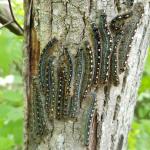 Forest Tent Caterpillar: Malacosoma disstria egg hatch occurs between 192-363 GDD’s, base 50°F, by mid-late May and caterpillars may be active for at least 5-6 weeks following. Susceptible hosts whose leaves are fed on by this insect include oak, birch, ash, maple, elm, poplar, and basswood. This native insect has many natural enemies, including some very effective pathogens that typically regulate populations. However, outbreaks of this insect can occur on occasion.
Forest Tent Caterpillar: Malacosoma disstria egg hatch occurs between 192-363 GDD’s, base 50°F, by mid-late May and caterpillars may be active for at least 5-6 weeks following. Susceptible hosts whose leaves are fed on by this insect include oak, birch, ash, maple, elm, poplar, and basswood. This native insect has many natural enemies, including some very effective pathogens that typically regulate populations. However, outbreaks of this insect can occur on occasion.- Hemlock Looper: Two species of geometrid moths in the genus Lambdina are native insects capable of defoliating eastern hemlock, balsam fir, and white spruce. Adult moths lay their eggs on the trunk and limbs of hosts in September and October, and eggs will hatch by late May or early June. (L. fiscellaria caterpillars may be active between 448-707 GDD’s.) Monitor susceptible hosts for small, inch-worm like caterpillars. Where populations are low, no management is necessary. Hemlock loopers have several effective natural enemies.
 Imported Willow Leaf Beetle: Plagiodera versicolora adult beetles overwinter near susceptible hosts. Adult beetles will chew holes and notches in the leaves of willow once they become available. Females lay yellow eggs in clusters on the undersides of leaves. Larvae are slug-like and bluish-green in color. They will feed in clusters and skeletonize the leaves. Most plants can tolerate the feeding from this insect, and foliage will appear brown. Repeated yearly feeding can be an issue, in which case management of the young larvae may be necessary. Take care with treatment in areas near water.
Imported Willow Leaf Beetle: Plagiodera versicolora adult beetles overwinter near susceptible hosts. Adult beetles will chew holes and notches in the leaves of willow once they become available. Females lay yellow eggs in clusters on the undersides of leaves. Larvae are slug-like and bluish-green in color. They will feed in clusters and skeletonize the leaves. Most plants can tolerate the feeding from this insect, and foliage will appear brown. Repeated yearly feeding can be an issue, in which case management of the young larvae may be necessary. Take care with treatment in areas near water.
Check out Episode 4 of InsectXaminer to see the imported willow leaf beetle in action: https://ag.umass.edu/landscape/education-events/insectxaminer
- Japanese Cedar Longhorned Beetle: Almost on an annual basis, UMass Extension receives questions about evidence of wood boring beetle attack on eastern redcedar and similar hosts, including but not limited to: American arborvitae, Atlantic white cedar, common juniper, false arborvitae, Hinoki cypress, Japanese cedar, Leyland cypress, and others. The culprit could be the Japanese cedar longhorned beetle (Callidiellum rufipenne) or our native cedar tree borer (Semanotus ligneus). C. rufipenne is discussed here. We recommend submitting samples of the damaged plant material and any insect life stages to the UMass Plant Diagnostics Laboratory: https://ag.umass.edu/services/plant-diagnostics-laboratory/tree-shrub-diagnostics-pinewood-nematode-assay .
The Japanese cedar longhorned beetle was first detected in Washington state in 1954. This wood boring beetle is found in conifers belonging to the cypress family. Primary hosts noted for this species include arborvitae, cypress, juniper, and cedar (Chamaecyparis). Adult beetles are small, approximately ¼ to ½ inch in length with long antennae (males have antennae that are slightly longer than their bodies; females have shorter antennae). The females have reddish brown elytra (hardened wings) and the males appear darker in color (shiny blue-black) with red visible on the “shoulders” of the beetle (just behind the thorax). There is one generation per year, although in colder locations it may take 2 years to complete its life cycle. Once the females emerge from their host, they begin to lay eggs in the cracks and crevices of bark during their 20-day life span. Each female lays approximately 20 eggs (Shibata, 1994). Eggs hatch within 2 weeks and the larvae bore beneath the bark, creating tunnels or galleries as they feed in the phloem and cambium layers of the tree or shrub. Larvae are cream colored with 3 pairs of thoracic legs and grow up to approximately ¾ inch in length. As many as 10 larvae may be found in a single arborvitae branch. When the larvae are mature, they enter the xylem where they pupate, which is suspected to occur in the fall. The Japanese cedar longhorned beetle is thought to overwinter as an adult within the host plant, and emerges early the next season in the spring (Hoebeke, 1999; Humphreys and Allen, 2000; Maier and Lemmon, 2000). However, depending upon geographic location, there is discrepancy between sources regarding the overwintering life stage of this insect.
The feeding damage from the larvae of this insect causes branch dieback which may not be noticed until the following spring after initial infestation. Other signs of this insect include frass found near galleries and splits in the bark and 1/8 inch, oval exit holes. Bark may appear puckered where larval mining occurs, and frass can be seen within the mines if they are exposed by splits in the bark. Frass-packed galleries occur in the cambium and xylem. Monitor for this insect, especially in Suffolk and Nantucket Counties in Massachusetts. May also be present elsewhere in the state. Look for branch dieback on susceptible hosts in the spring. Look for bark splits, galleries, frass, and oval exit holes. With caution and the proper tools, slice open dying branches to look for galleries in the cambium and xylem and also potentially expose larvae, pupae, or adult beetles.
Borers may be preferentially attracted to stressed plants. Take precautions to avoid plant stress, such as proper planting and site selection. Prune out and destroy infested branches prior to adult emergence in the spring. In Japan, Shibata (1994) determined that approximately 53% of pre-adult Japanese cedar longhorned beetles succumb to disease or parasitism by a suite of natural enemies. Most of the larval mortality occurs due to (as of yet) unidentified diseases; some pupal mortality occurs due to disease as well. Before pupation, larvae are also killed by two important parasitoids - Doryctes yogoi and Ischnoceros sapporensis. Two species of parasitoids from the pupal cells of Japanese cedar longhorned beetles are also known - Baeacis semanoti and Rhimphoctona spp. (Invasive Species Compendium; CABI). The full impact of natural enemies on this insect in the United States is not completely understood.
- Lecanium Scales (Oak): Parthenolecanium quercifex overwinters as a second instar nymph on oak twigs. Females will begin feeding and mature in the spring, from mid-April to early May and eggs may be laid between late May and into June. Eggs hatch in June or early July and crawlers migrate to host plant leaves where they spend the summer and migrate as second instars back to host plant twigs in the fall. Mid-April to early-May (35-145 GDD’s) for dormant oil applications.
 Lily Leaf Beetle:Lilioceris liliiadults overwinter in sheltered places. As soon as susceptible hosts such as Lilium spp. (Turk’s cap, tiger, Easter, Asiatic, and Oriental lilies) and Fritillaria spp. break through the ground, the adult lily leaf beetles are known to feed on the new foliage. (Note: daylilies are not hosts.) Typically, in May, mating will occur and each female will begin to lay 250-450 eggs in neat rows on the underside of the foliage. If there are only a few plants in the garden, hand picking and destroying overwintering adults can help reduce local garden-level populations at that time.
Lily Leaf Beetle:Lilioceris liliiadults overwinter in sheltered places. As soon as susceptible hosts such as Lilium spp. (Turk’s cap, tiger, Easter, Asiatic, and Oriental lilies) and Fritillaria spp. break through the ground, the adult lily leaf beetles are known to feed on the new foliage. (Note: daylilies are not hosts.) Typically, in May, mating will occur and each female will begin to lay 250-450 eggs in neat rows on the underside of the foliage. If there are only a few plants in the garden, hand picking and destroying overwintering adults can help reduce local garden-level populations at that time.
Check out Episode 3 of InsectXaminer to see the lily leaf beetle in action:https://ag.umass.edu/landscape/education-events/insectxaminer
- Magnolia Scale: Neolecanium cornuparvum overwinters as first instar nymphs which are elliptical, and dark slate gray in color and can usually be found on the undersides of 1 and 2 year old twigs. Nymphs may molt by late April or May and again by early June at which time the scales may be purple in color. Eventually nymphs secrete a white powdery layer of wax over their bodies. Dormant oils can be applied between 7-35 GDD’s targeting the overwintering nymphs. Avoid applications to opening buds or blooms.
- For more information, visit: https://ag.umass.edu/landscape/fact-sheets/magnolia-scale .
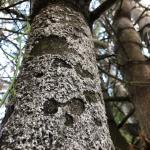 Pine Bark Adelgid: Pineus strobi overwinters as an immature which begins feeding during the first days of warm weather in the spring and begins secreting white wax over itself, which can eventually coat the entire trunk of infested trees. Egg laying may begin in April. This insect can be found on the trunk, branches, twigs, and the base of needles on new shoots. Spruce is a secondary host but this adelgid can repeatedly reproduce itself on pine. Wash off bark with a strong jet of water. If necessary, dormant oil applications can be made in mid-late April between 22-58 GDDs. Hosts include eastern white, Scots, and Austrian pines. This insect does little damage to healthy trees and can often be tolerated.
Pine Bark Adelgid: Pineus strobi overwinters as an immature which begins feeding during the first days of warm weather in the spring and begins secreting white wax over itself, which can eventually coat the entire trunk of infested trees. Egg laying may begin in April. This insect can be found on the trunk, branches, twigs, and the base of needles on new shoots. Spruce is a secondary host but this adelgid can repeatedly reproduce itself on pine. Wash off bark with a strong jet of water. If necessary, dormant oil applications can be made in mid-late April between 22-58 GDDs. Hosts include eastern white, Scots, and Austrian pines. This insect does little damage to healthy trees and can often be tolerated.
-
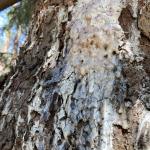 Pitch Mass Borer: Synanthedon pini is a native clearwing moth whose larvae feed within various pines and spruce. Feeding by the larvae (caterpillars) of this insect causes pitch masses to form on host plants. Two or three years are required for this insect to complete its life cycle, with adult moths present during the summer. Adult pitch mass borer moths may resemble wasps. Adult males and females are blue/black from above, marked with a patch of red/orange on the underside of the abdomen, with some orange on the top of the fourth abdominal segment. Orange is also found along the sides of the abdomen. Forewings are black/blue in color and opaque with wing length of 0.47 to 0.59 inches. Adults are said to emerge, mate, and females lay eggs on their hosts some time in July. By the late summer, the larvae (immatures; caterpillars) bore into their host plant, tunneling through the trunks, often directly beneath a branch. Larvae have uniformly dark brown heads, white bodies, and prolegs with rows of 6-8 crochets on the bottom of their "feet". At the site of the borer wound, large amounts of pitch exude from the tree in a hemispherical mass above the larval tunnels. Larvae continue to feed and develop in the tree through the following year, and it is thought that caterpillars may take up to two years to mature. Masses may be 3-4 inches in diameter. Pupation occurs in a subsequent end of May through June in time for adult emergence by July and August. Pupal cells are formed within the pitch mass and lined with silk (Beuttenmüller, 1901). Pupae are 0.73 inches long and light brown in color (Kellicott, 1881).
Pitch Mass Borer: Synanthedon pini is a native clearwing moth whose larvae feed within various pines and spruce. Feeding by the larvae (caterpillars) of this insect causes pitch masses to form on host plants. Two or three years are required for this insect to complete its life cycle, with adult moths present during the summer. Adult pitch mass borer moths may resemble wasps. Adult males and females are blue/black from above, marked with a patch of red/orange on the underside of the abdomen, with some orange on the top of the fourth abdominal segment. Orange is also found along the sides of the abdomen. Forewings are black/blue in color and opaque with wing length of 0.47 to 0.59 inches. Adults are said to emerge, mate, and females lay eggs on their hosts some time in July. By the late summer, the larvae (immatures; caterpillars) bore into their host plant, tunneling through the trunks, often directly beneath a branch. Larvae have uniformly dark brown heads, white bodies, and prolegs with rows of 6-8 crochets on the bottom of their "feet". At the site of the borer wound, large amounts of pitch exude from the tree in a hemispherical mass above the larval tunnels. Larvae continue to feed and develop in the tree through the following year, and it is thought that caterpillars may take up to two years to mature. Masses may be 3-4 inches in diameter. Pupation occurs in a subsequent end of May through June in time for adult emergence by July and August. Pupal cells are formed within the pitch mass and lined with silk (Beuttenmüller, 1901). Pupae are 0.73 inches long and light brown in color (Kellicott, 1881).Adult moths are active during the summer. Following egg laying and egg hatch, the larvae tunnel under the bark to the cambium. Obvious, large globs of pitch appear on trunks. Occurs sporadically on individual trees. Host trees with active caterpillars have pitch masses that may appear coated in a white, powdery substance. Larvae may also preferentially bore into the host beneath a broken branch or scar. This insect will attack large trees, up to 30-40 feet from the ground. Healthy trees are also preferentially utilized. Overall damage to the health of the host tree is typically not extensive, and therefore chemical management of this insect is often unnecessary.
Pitch can be removed and the single larva within destroyed. Physical/mechanical management of this insect, if it can be safely done, is a great way to manage the pitch mass borer on individual specimen trees. The act of just pulling the caterpillar from its pitch mass will kill it - much to the frustration of history's entomologists looking to study them - as soon as contact of the pitch is made with the caterpillar's body and hardens and adheres to them. Parasitism by natural enemies is reported to be relatively common. Parasitic wasps in the family Eulophidae are noted but not specified, as well as a caterpillar-eating species of fly (Engelhardt, 1946).
- Snowball Aphid: Neoceruraphis viburnicola eggs overwinter on viburnum twigs and buds. Eggs hatch and this aphid becomes active on certain species of viburnum roughly between 148-298 GDD’s or around redbud bloom. This insect is particularly noticeable on V. opulus, V. prunifolium, and V. acerifolia. Stem mothers, appearing blueish-white, can be found in curled up and distorted foliage. Damage caused by this insect pest is mostly aesthetic.
- Spruce Bud Scale: Physokermes piceae is a pest of Alberta and Norway spruce, among others. Immatures overwinter on the undersides of spruce needles, dormant until late March. By April, females may move to twigs to complete the rest of their development. Dormant oil applications may be made between 22-121 GDDs. Follow all label instructions, as oil may remove the bluish color from certain conifers. Mature scales are reddish brown, globular, 3 mm. in diameter, and found in clusters of 3-8 at the base of new twig growth. They closely resemble buds and are often overlooked. Crawlers are present around June.
- Spruce Spider Mite: Oligonychus ununguisis a cool-season mite that becomes active in the spring from tiny eggs that have overwintered on host plants. Hosts include spruce, arborvitae, juniper, hemlock, pine, Douglas-fir, and occasionally other conifers. This particular species becomes active in the spring and can feed, develop, and reproduce through roughly June. When hot, dry summer conditions begin, this spider mite will enter a summer-time dormant period (aestivation) until cooler temperatures return in the fall. This particular mite may prefer older needles to newer ones for food. When damaging spruce spider mite populations are known from last season, dormant oil applications can be made (when temperatures are appropriate according to label instructions) between 7-121 GDD’s, base 50°F (April). Magnification is required to view spruce spider mite eggs. Tapping host plant branches over white paper may be a useful tool when scouting for spider mite presence. (View with a hand lens.) Spider mite damage may appear on host plant needles as yellow stippling and occasionally fine silk webbing is visible.
- Viburnum Leaf Beetle: Pyrrhalta viburni is a beetle in the family Chrysomelidae that is native to Europe, but was found in Massachusetts in 2004. Viburnum leaf beetle overwinters as eggs laid in capped pits on the newest growth of susceptible viburnum branches. Scout for overwintered eggs and prune out and destroy before they hatch. Egg hatch occurs in late-April to early-May as temperatures warm and foliage becomes available. Monitor for larvae in mid-May (80-120 GDD’s). This beetle feeds exclusively on many different species of viburnum, which includes, but is not limited to, susceptible plants such as V. dentatum, V. nudum, V. opulus, V. propinquum, and V. rafinesquianum. Some viburnum have been observed to have varying levels of resistance to this insect, including but not limited to V. bodnantense, V. carlesii, V. davidii, V. plicatum, V. rhytidophyllum, V. setigerum, and V. sieboldii. More information about viburnum leaf beetle may be found athttp://www.hort.cornell.edu/vlb/ and here: https://ag.umass.edu/landscape/fact-sheets/viburnum-leaf-beetle .
- White Pine Weevil: Pissodes strobi adults overwinter in sheltered locations in the leaf litter and become active very early in the spring, when daytime temperatures reach 50°F and before the bloom of forsythia (between 7-58 GDDs). Hosts include eastern white pine, Norway spruce, scotch, pitch, and red pine, blue spruce, and white spruce. Adults will begin feeding on bark 7-10 inches below dormant terminal buds. Females will deposit eggs in terminal growth bark, and developing larvae will feed in leaders until they mature in July when pupation occurs in pupal chambers made of wood chips. Management in nurseries or Christmas tree production may be necessary. Target adults between 7-58 GDD’s.
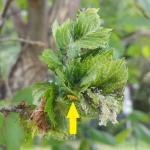 Woolly Apple Aphid:Eriosoma lanigerum may be found on apple, crabapple, hawthorn, mountain-ash, Pyracantha, and elm hosts. The primary (winter) host is elm, on which aphids infest emerging spring leaves, causing leaves to curl or close into stunted, rosette-like clusters found at twig tips. On apple and crabapple, this species of aphid colonizes roots, trunks, and branches in the summer and is commonly found near previous wounds or callous tissue. On roots, the aphids cause swelled areas which can girdle and kill roots. The aphids, when found in above ground plant parts such as elm leaves, are covered with white wax. Eggs are the overwintering stage on elm, which hatch in the spring in time for the nymphs to infest new elm foliage. Following a few generations on elm, the aphids will develop into a winged form, which will disperse and seek out apple and crabapple. Multiple generations will occur on these alternate hosts in the summer and by the fall, a winged form will return to elm and mated females will lay eggs near elm buds. These aphids are a favorite snack for insect predators such as the multicolored Asian lady beetle, Harmonia axyridis.
Woolly Apple Aphid:Eriosoma lanigerum may be found on apple, crabapple, hawthorn, mountain-ash, Pyracantha, and elm hosts. The primary (winter) host is elm, on which aphids infest emerging spring leaves, causing leaves to curl or close into stunted, rosette-like clusters found at twig tips. On apple and crabapple, this species of aphid colonizes roots, trunks, and branches in the summer and is commonly found near previous wounds or callous tissue. On roots, the aphids cause swelled areas which can girdle and kill roots. The aphids, when found in above ground plant parts such as elm leaves, are covered with white wax. Eggs are the overwintering stage on elm, which hatch in the spring in time for the nymphs to infest new elm foliage. Following a few generations on elm, the aphids will develop into a winged form, which will disperse and seek out apple and crabapple. Multiple generations will occur on these alternate hosts in the summer and by the fall, a winged form will return to elm and mated females will lay eggs near elm buds. These aphids are a favorite snack for insect predators such as the multicolored Asian lady beetle, Harmonia axyridis.
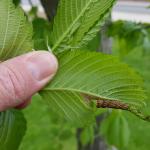 Woolly Elm Aphid: Eriosoma americanum females lay a single egg in the cracks and crevices of elm bark, where the egg overwinters. Eggs hatch on elm in the spring as leaves are unfolding. Aphids may be active from 121-246 GDD’s, base 50°F on elm. A young, wingless female hatched from the egg feeds on the underside of leaf tissue. This female aphid matures and gives birth to 200 young, all females, without mating. These aphids feed, and the elm leaf curls around them and protects them. By the end of June, winged migrants mature and find serviceberry hosts. Another set of females is produced. These new females crawl to and begin feeding on the roots of serviceberry. Multiple generations occur on the roots of serviceberry through the summer.
Woolly Elm Aphid: Eriosoma americanum females lay a single egg in the cracks and crevices of elm bark, where the egg overwinters. Eggs hatch on elm in the spring as leaves are unfolding. Aphids may be active from 121-246 GDD’s, base 50°F on elm. A young, wingless female hatched from the egg feeds on the underside of leaf tissue. This female aphid matures and gives birth to 200 young, all females, without mating. These aphids feed, and the elm leaf curls around them and protects them. By the end of June, winged migrants mature and find serviceberry hosts. Another set of females is produced. These new females crawl to and begin feeding on the roots of serviceberry. Multiple generations occur on the roots of serviceberry through the summer.
Concerned that you may have found an invasive insect or suspicious damage caused by one? Need to report a pest sighting? If so, please visit the Massachusetts Introduced Pests Outreach Project:http://massnrc.org/pests/pestreports.htm .
Reported by Tawny Simisky, Extension Entomologist, UMass Extension Landscape, Nursery, & Urban Forestry Program
Additional Resources
Pesticide License Exams - The MA Dept. of Agricultural Resources (MDAR) is now holding exams online. For more information and how to register, go to: https://www.mass.gov/pesticide-examination-and-licensing.
To receive immediate notification when the next Landscape Message update is posted, join our e-mail list or follow us on Facebook.
For a complete listing of upcoming events, see our upcoming educational events https://ag.umass.edu/landscape/upcoming-events
For commercial growers of greenhouse crops and flowers - Check out UMass Extension's Greenhouse Update website
For professional turf managers - Check out Turf Management Updates
For home gardeners and garden retailers - Check out our home lawn and garden resources.
Diagnostic Services
UMass Laboratory Diagnoses Landscape and Turf Problems - The UMass Extension Plant Diagnostic Lab is available to serve commercial landscape contractors, turf managers, arborists, nurseries and other green industry professionals. It provides woody plant and turf disease analysis, woody plant and turf insect identification, turfgrass identification, weed identification, and offers a report of pest management strategies that are research based, economically sound and environmentally appropriate for the situation. Accurate diagnosis for a turf or landscape problem can often eliminate or reduce the need for pesticide use. For sampling procedures, detailed submission instructions and a list of fees, see Plant Diagnostic Laboratory
Soil and Plant Nutrient Testing - The University of Massachusetts Soil and Plant Nutrient Testing Laboratory is located on the campus of The University of Massachusetts at Amherst. Testing services are available to all. The lab provides test results and recommendations that lead to the wise and economical use of soils and soil amendments. For more information, including current turn-around times, visit the UMass Soil and Plant Nutrient Testing Laboratory web site. The lab is currently accepting new orders for Routine Soil Analysis (including optional Organic Matter, Soluble Salts, and Nitrate testing), Particle Size Analysis, Pre-Sidedress Nitrate (PSNT), and Soilless Media (no other types of soil analyses available at this time). See https://ag.umass.edu/services/soil-plant-nutrient-testing-laboratory/ordering-information-forms/turnaround-time-for-routine-soil-analysis for current turnaround time. Please plan for the fact that date of receipt in the lab is affected by weekends, holidays, shipping time, and time for UMass Campus Mail to deliver samples to the lab.
Tick Testing - The UMass Center for Agriculture, Food, and the Environment provides a list of potential tick identification and testing options at: https://ag.umass.edu/resources/tick-testing-resources.
Acknowledgements: UMass Extension gratefully acknowledges the support of the following funding sources for the production of the Landscape Message –
- The Massachusetts Nursery and Landscape Association Fund
- The Massachusetts Department of Conservation and Recreation, Award #ISADCR28219926UMA22A
- Stakeholders like you! The Landscape Message is partially supported by educational program user fees.